How to Sell on Walmart Marketplace
Today’s ecommerce space is drastically different from its early stages. With the rise of internet use and online shopping, more and more businesses have recognized the importance of being visible on the web. This has led to a boom in virtual marketplaces that cater to people’s need to browse and “add to cart” from the comfort of their homes.
And since the landscape is evolving rapidly for sellers, expansion is now the name of the game. With double or triple the reach potential, you can easily multiply your sales at the same time. Multi-channel selling can also amp up your brand and enhance visibility across customer segments.
Plus, it also helps diversify your revenue streams and makes you less dependent on a single platform. If one marketplace experiences a dip in sales due to external factors, you have other platforms to fall back on.
But where else should you sell your products? Which platform would be worth the effort and risk? Well, that’s where Walmart Marketplace comes in.
Walmart has been a household name for decades. And with its reputation for quality and affordability, it’s no surprise that its online marketplace is gaining traction. In fact, it boasts about 400 million monthly visitors, making it one of the largest online marketplaces, ranking seventh in the world and second in the US. This massive traffic presents a golden opportunity for sellers looking to expand and increase sales.
But before diving into selling on Walmart Marketplace, it’s important to understand the platform and how it works. Here’s everything you need to know.
What Is Walmart Marketplace?

Simply put, Walmart Marketplace is an online platform where third-party sellers can offer their products to a vast customer base. It’s similar to other online marketplaces like Amazon and eBay but with its own unique features and benefits.
Through Walmart Marketplace, sellers have the opportunity to take advantage of Walmart’s trusted brand name. The approval and selection process on the platform is known to be rigorous. So, consumers view those who pass as reputable and reliable sellers.
Walmart Marketplace is also one of the fastest-growing online marketplaces. The company has long cemented itself as a retail giant in the US food and grocery industry. Now, it has also made a significant dent in the world of ecommerce. In 2022, a third of US sellers on the platform were able to earn $500,000 to $1,000,000. This shows how profitable it can be to start selling there.
If you’re a seller nervous about joining Walmart, or you’re already trading on marketplaces but want to expand even further, this guide is for you.
Understanding Walmart’s Seller Requirements
Stepping into Walmart Marketplace might seem daunting at first, but the process is easy and fast as long as your documents are complete. Here are a few key items you’ll need to check off your list:
- US Business Tax ID or Business License Number
- Supporting documents that would verify your US business name and address (for physical stores). Examples would be a W9 or W8.
- Established store or presence in other ecommerce marketplaces, such as Amazon
- Products that aren’t ruled out by Walmart’s Prohibited Products Policy
- GTIN/UPC or GS1 Prefix
- Fulfillment account with WFS (Walmart Fulfillment Services) or other B2C US warehouses that support returns
Once you have everything above ready, here’s a quick overview of the application process to get the ball rolling:
- Step 1: It all starts with creating a Walmart Marketplace Account. Head over to marketplace.walmart.com and click on “Join Marketplace” to begin your adventure.
- Step 2: Verify your email address to prove you’re not a robot.
- Step 3: Log in to your new account.
- Step 4: Set up your account by completing 3 essential steps inside the Walmart Seller Center.
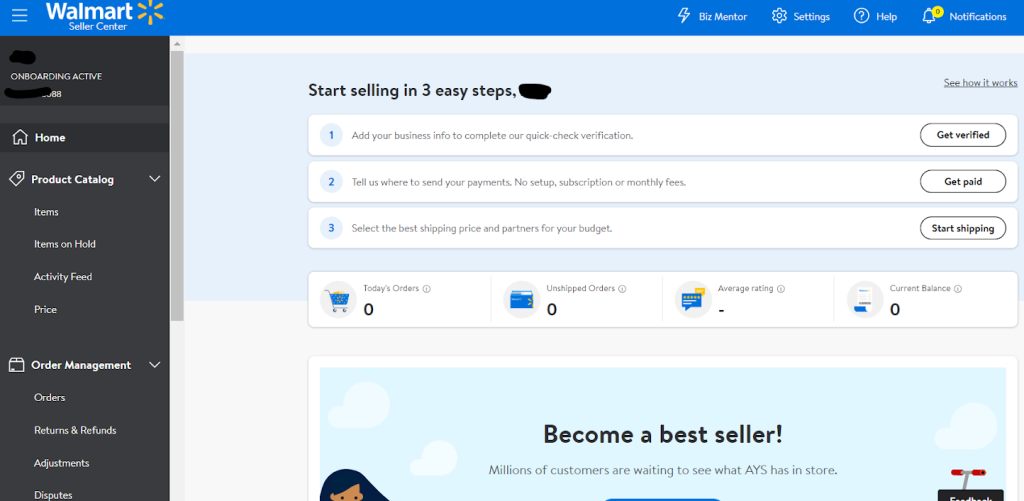
Add Business Information to Complete a Quick Check
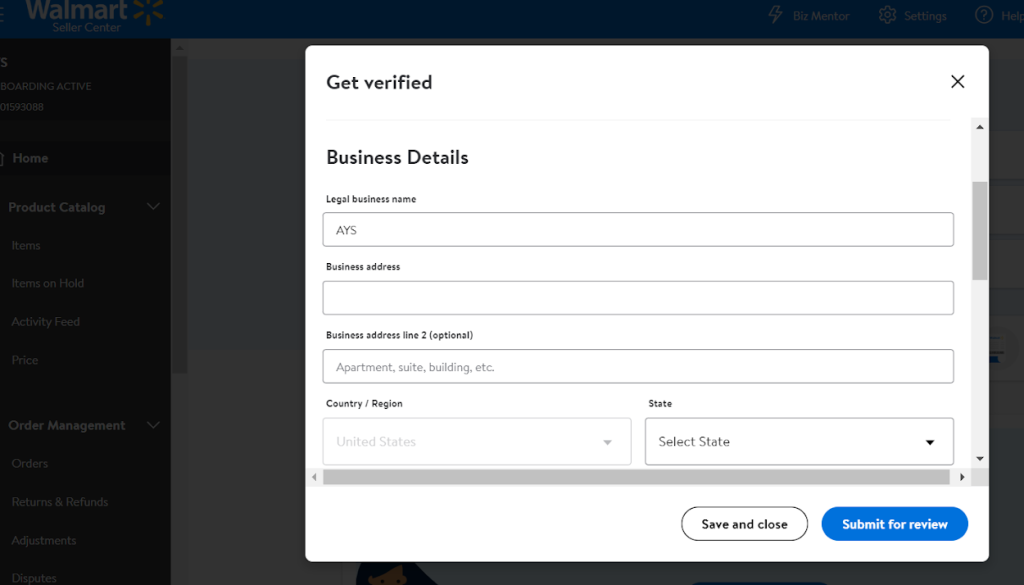
The first step is to complete your verification and set up your profile. Click on “Get Verified” to start. You’ll mainly fill out two major sections:
- Business Details: Here, you’ll input your legal business name and address. You’ll also need to add a primary contact number, your website, and annual gross merchandise value (GMV), and highlight what you’re best at selling.
- Seller Profile: This is the info your customers will see. Add your display name, a US-based customer service phone number, and your customer service email.
For international sellers, a US tax ID is a must. No worries if you don’t have one yet—Walmart itself will guide you through the process. You’ll just be asked for additional details like your performance on other platforms. You’ll also be asked for your top brands and concrete proof of your business’s storefront.
After checking all the boxes, hit “Submit for Review.” If you need to make updates, just save and close, then return when ready.
Your application’s status can be monitored through your account. Plus, look out for an email of confirmation of approval and verification.
Add a Payment Method Where You’ll Receive Earnings
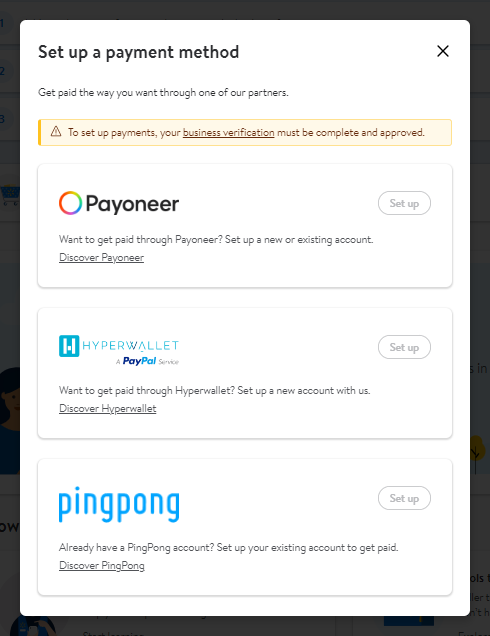
Next, tap “Get Paid” to explore payment options with Walmart’s partnered financial services. You can choose from Payoneer, Hyperwallet, and PingPong. Ensure your business verification is complete prior to this step.
Upon approval, selecting “Set Up” redirects you to your chosen payment provider’s portal. Existing account holders can log in to finalize setup, while new users have the option to create a new account.
Set Up Your Shipping Options
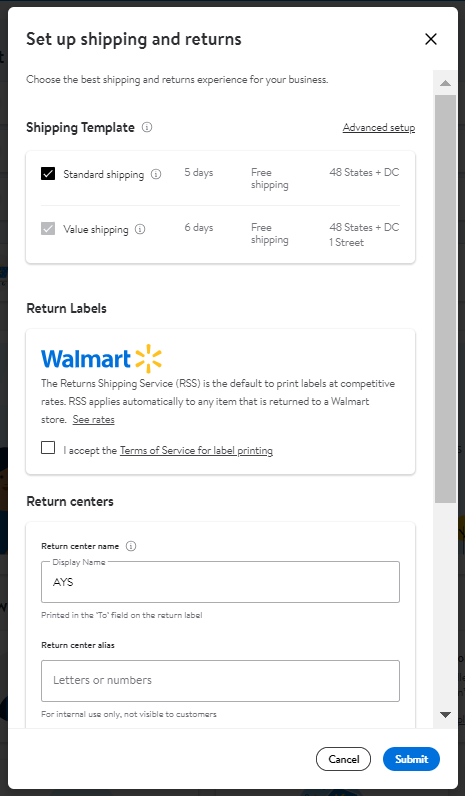
Adding your shipping details wraps up the setup of your seller account. And the good news is you can do this while waiting for your business info to be approved and verified. Just hit “Start Shipping.”
You’ll see a pop-up with three key sections: (1) shipping templates, (2) return labels and (3) return centers. The shipping template lets you pick how fast and how much shipping will cost. There are options like Standard Shipping (5 days) and Value Shipping (6 days).
When setting up return labels, you’ll first agree to Walmart’s terms. Then, set up where returns should be sent, including the address and the name of the return label. Want more control? Click “Advanced Setup” to create shipping rules based on order weight or price. Once done, just click “Submit.”
Setting Up for Success on Walmart Marketplace
Once your Seller Center profile has been approved, you can start setting up for success on Walmart Marketplace. This involves adding your products, optimizing your listings and inventory, and pricing everything.
List Products Effectively
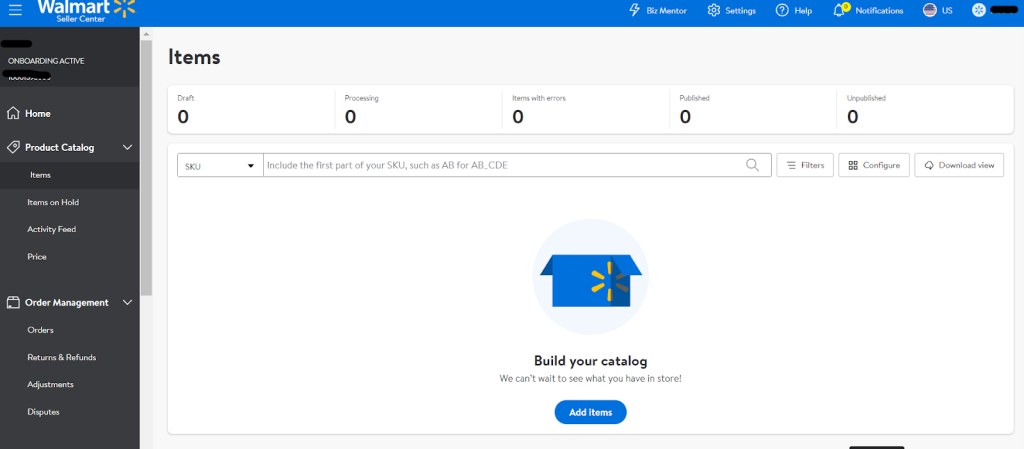
After completing the initial setup for your Walmart Seller account, the next crucial step is listing your products. Navigate to the “Product Catalog” section found on the left sidebar and select “Item” to get started.
Walmart simplifies the product listing process by offering three methods: (1) uploading a spreadsheet of your inventory, (2) importing your entire store catalog, or (3) utilizing the Walmart Catalog to find and list products one at a time.
1. Uploading a Spreadsheet
If you opt to use a spreadsheet to list items, you can use either the Full Setup Excel Template or quick setup by match. You’ll see these two options upon clicking “Manage Items” and selecting “Add Items” from the dropdown menu. You’ll then see a Walmart template link under the “Upload a spreadsheet” section. From there, you can choose either “Create a full-setup template” or “Set up items by match.”
“Full Setup” lets you upload items in seven categories at a time and can have multiple columns for various attributes that your products might have. You’ll be asked to select your fulfillment type on the “Add items in bulk” page. Then, you’ll be asked to choose your product categories from the “Find a Category” dropdown. Make sure to select the correct option as the attributes depend on the category type. If you’re unsure about what each means, you can refer to Walmart’s Item Categorization Guide.
With “Set Up Items by Match,” you’ll get a different downloadable template that has a few primary fields and is made for sourcing products from Walmart directly. There are also optional fields, like the Product Category and External Product ID, which can help your items get better match rates. Just note that this method can only be used for seller-fulfilled items.
After the upload, a checkmark will appear next to your file and you’ll see a “Next” button at the bottom left of the screen. If your listings have no errors or violations, an “Import Items” button will show on the next screen. Alternatively, if your catalog still needs to be aligned with Walmart standards, you’ll get a button to “Activate the experts.” This will prompt Walmart associates to help you get your listings up to code with no additional charges.
2. Importing Your Entire Store Catalog
Another method is to import your catalog from your existing Amazon, Etsy, eBay, Target, Shopify, or Wayfair store. Just select your source store under the “Import your store” button and make sure you paste the right link. Walmart will use this URL to get as much data as possible, but there will still be some prices, SKUs, and other details that you’ll need to set up manually.
For sellers seeking efficiency, there’s a hassle-free way to replicate success across marketplaces. ExportYourStore lets sellers with established storefronts on platforms like Shopify, eBay, Etsy, and more expand their reach to the Walmart Marketplace.
ExportYourStore helps you list products according to Walmart’s specific format and rules. Once your items are uploaded, it also ensures updated stock levels across all your sales channels. For example, if you make a sale on a site like Amazon or Poshmark, ExportYourStore will automatically reduce your stock level on Walmart to match.
The Walmart integration is currently in beta, but interested sellers can contact the team for access.
Ready to take your online business multi-channel? Consider starting a free trial of ExportYourStore to effortlessly extend your market presence.
3. Matching Items to Listings One at a Time
The third option is to “Search the Walmart catalog,” but it’s only advisable for single-item uploads. You’d need to manually search for each product using its GTIN, UPC, or Walmart ID, so it’ll be quite tedious if you have a lot of items to list. To push through with this method, just click “Add item” after each setup.
Update Inventory and Optimize Your Listings
Once your items receive the green light and are featured on the platform, the next step involves inventory management. Uploading your inventory can be done manually. Or for those with a more extensive selection, using an Excel template for bulk updates may be preferred.
The essential details required include the SKU, the number of items available, and the ID for the fulfillment center. For smaller adjustments or updates to just a few products, this can easily be managed directly using the Bulk Attribute Editor in the Seller Center.
Large-scale sellers with sophisticated inventory systems might consider API integration with Walmart. This will streamline the update process and ensure that the stock levels are always accurate. Third-party solution providers are also an option for those seeking white-glove assistance.
Upon completing these setup stages, your virtual storefront is ready to go live. To ensure your products stand out, it’s crucial to add high-quality imagery. High-resolution photos that accurately represent your products can enhance the customer’s shopping experience. After all, they’ll have a clear understanding of what they are purchasing.
Also, write detailed, search friendly product descriptions that adhere to Walmart’s guidelines. This will provide clarity and confidence for your customers. It’ll also optimize your listings for better visibility and sales performance.
Set and Adjust Prices Intuitively

Walmart is known for its commitment to low prices. And much like Amazon, Walmart is also a seller on its own marketplace. This means you can end up getting undercut by the platform itself.
Sellers also have to adhere to Walmart’s pricing policy and avoid pricing too high in comparison to other offers—even offers on other websites. Failing to do so can cost you the Buy Box or even get your offer unpublished.
To stand out, it’s important to know your competition. Price your products effectively and in a way that makes them irresistible to customers. To maintain an edge, you can also consider using tools designed for product research and automatic repricing.
Additionally, offer products that are difficult to find in Walmart’s physical stores. By doing this, you can tap into a unique market segment that seeks the convenience and exclusivity of online shopping.
You can even try retail and online arbitrage to expand your catalog. With a Walmart-approved solution like DataSpark, you can find items you can easily buy and resell at a higher price point. Its research tools include a Chrome extension for Amazon-to-Walmart arbitrage and a wholesale analyzer built just for Walmart Marketplace.
Maximizing Visibility and Sales on Walmart
Success on Walmart is largely influenced by how well sellers can match listings with the platform’s search algorithms. These prioritize items based on factors like the product title, description, category, pricing, and seller’s performance metrics. Understanding and optimizing these factors can significantly improve product visibility and sales.
Win the Walmart Buy Box
Winning the Walmart Buy Box is a key strategy for increasing sales. Similar to Amazon with their Buy Box, Walmart favors listings with competitive pricing. With a cheaper option available, your products might be added to the “More Sellers” section. This will significantly reduce their visibility.
However, to secure the coveted Buy Box, sellers must consider more than just pricing. Offering comprehensive value through shipping options can also set your listings apart.
Maintain superior seller performance through fast and reliable delivery. Minimize order defects, and ensure high customer satisfaction across the board. You should also optimize product listings with relevant keywords, top-quality images, and thorough descriptions. This ensures that they appear in your potential buyers’ searches. Finally, keep inventory levels accurate and avoid running out of stock, as this can lead to a Buy Box loss as well.
Want to gain the edge over the competition? DataSpark’s Keyword Explorer helps you find the highest-value keywords on Walmart Marketplace the quick and easy way.
Advertise on Walmart
Running ads on Walmart with Sponsored Products can make individual listings more visible. With them, you can place items higher in search results and product detail pages, based on a pay-per-click model.
Brand Ads is an alternative. It boosts visibility by letting sellers advertise across strategic locations on Walmart. Make sure to use Walmart AdCenter for tracking ad performance and adjusting bids and strategy. Use data as your basis to maximize effectiveness.
Enhance Customer Experience to Guarantee Repeat Walmart Buyers

As with any other marketplace, customer service is critical for Walmart. And with Walmart ranking as the second-largest e-commerce retailer in the US in 2023, you need to step up your game as a third-party seller. Excellent support can help reduce the chances of receiving negative feedback. It also encourages repeat buyers.
Make sure to respond promptly to customer inquiries and address any issues efficiently. Admittedly, this is easier said than done when balancing support for other channels like your Amazon account or Shopify store. You can streamline your operation by investing in top-notch customer service software like Onsite Support, a trusted Walmart Specialty Solution Provider.
Onsite Support is designed to help you navigate these waters smoothly. Here’s how:
Centralized Customer Support
Handling inquiries across multiple selling platforms can be daunting. Onsite Support offers a single inbox that lets you manage customer concerns from Walmart, Amazon, your website, and other ecommerce channels, all in one place. This integration not only saves time but also enhances efficiency so you can offer consistent, high-quality customer service.
Personalized Customer Interactions
Personalization goes a long way in customer service. Onsite Support gathers relevant customer data, including order number, shipping status, and tracking ID. It even lets you automatically enter these in canned replies. This lets you provide responses that don’t just solve issues more efficiently, but also foster trust and loyalty.
More Timely Responses
Walmart imposes a strict 48-hour response window for sellers to reply to customer messages. Falling below a 95% on-time response rate will prevent you from earning a Pro Seller badge. Worse numbers can even invite penalties. But, with Onsite Support, you can ensure timely responses and maintain a stellar seller reputation.
Cost Savings
Forget about expanding your customer service team to handle additional platforms. With Onsite as your integrated Walmart helpdesk, your team can manage all inquiries in the same interface, even those from other sites like Amazon. This cuts down on support costs—as dramatically proven by successful Walmart sellers like Miko.
Walmart Compliance and Customer Satisfaction
Onsite Support is for businesses that not only want to meet Walmart’s stringent customer care requirements, but exceed them. Offer professional, timely service and turn customer interactions into positive experiences. Whether it’s issuing refunds or updating shipping statuses, you can do it all without leaving the app.
With this all-in-one support tool, you ensure each customer interaction is not just satisfactory but exceptional.
Encourage Reviews and Manage Feedback on Walmart

Encouraging positive customer reviews is essential for building trust and persuading potential customers. Stellar reviews often result from an excellent shopping experience, timely shipping, and quality products, after all.
To stay ahead of negative reviews and prevent escalations, consider getting feedback software. Specifically, one that can notify you instantly once someone leaves a product review so you can maintain a positive brand image.
FeedbackWhiz Alerts is a promising option. It was initially developed for Amazon but is now also supporting Walmart. It allows sellers to receive real-time notifications about reviews. So, you’d stay informed about customer feedback and swiftly address any issues. See if it’s a good fit for free with a 30-day trial of FeedbackWhiz.
Manage Finances Accurately and Efficiently at Walmart
On fast-paced platforms like Walmart, accurate finances are not just beneficial—they’re essential. However, managing online sales can be complex. It involves navigating through sales revenues, taxes, various fees, refunds, and more.
For ecommerce sellers, maintaining a keen eye on these details is important. After all, it can greatly impact both profitability and decision-making. That’s where FeedbackWhiz Profits enters the picture. It’s a solution previously exclusive to Amazon sellers. But now, it’s extending its bookkeeping capabilities to Walmart retailers.
This tool is ingeniously designed to streamline ecommerce accounting at Walmart. It automatically compiles critical financial data, including sales, taxes, and fees. It also allows the tracking of custom expenses.
With this integration, Walmart entrepreneurs gain access to a comprehensive Profits dashboard. See key metrics such as profit comparisons between Walmart Fulfillment Services and seller-fulfilled transactions. You also get detailed breakdowns of Walmart fees and analyses of refunds, alongside specifics per item. Experience the difference by trying FeedbackWhiz free for 30 days.
Expand into Walmart with Ease
Venturing into a new marketplace is undeniably nerve-wracking. You don’t know if your products will succeed, how receptive customers will be, or if challenges may arise.
However, the potential returns are surely worth the risk. Walmart’s reach is impressive. And with its growing popularity, it’s a platform that online sellers shouldn’t overlook.
For greater efficiency and surefire success, consider having Onsite Support as your scaling partner. Get the customer support tools and support necessary to not only enter but also thrive on Walmart.





